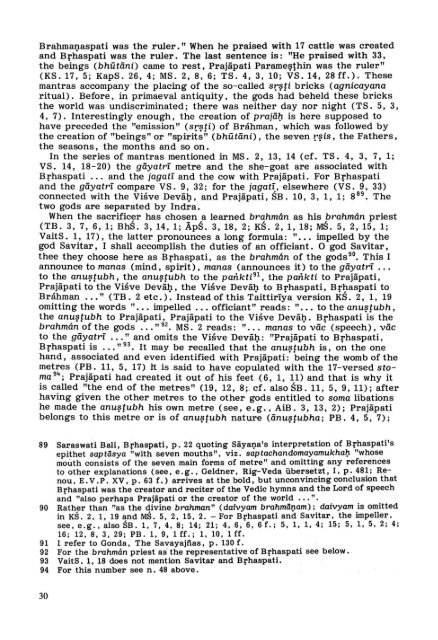Prajapati's relations with Brahman, Brhaspati and Brahma - DWC
Prajapati's relations with Brahman, Brhaspati and Brahma - DWC
Prajapati's relations with Brahman, Brhaspati and Brahma - DWC
Create successful ePaper yourself
Turn your PDF publications into a flip-book with our unique Google optimized e-Paper software.
<strong>Brahma</strong>I]aspati was the ruler." When he praised <strong>with</strong> 17 cattle was created<br />
<strong>and</strong> <strong>Brhaspati</strong> was the ruler. The last senten ce is: "He praised <strong>with</strong> 33,<br />
the beings (bhütäni) came to rest, Prajäpati Parameflthin was the ruler"<br />
(KS. 17,5; KapS. 26, 4; MS. 2, 8, 6; TS. 4, 3, 10; VS. 14, 28ff.). These<br />
mant ras accompany the placing of the so-called sr~ti bricks (agnicayana<br />
ritual). Before, in primaeval antiquity, the gods had beheld these bricks<br />
the world was undiscriminated; there was neither day nor nigpt (TS. 5, 3,<br />
4, 7). Interestingly enough, the creation of prajä1; is here supposed to<br />
have preceded the "emission" (sr~ti) of Bráhman, which was followed by<br />
the creation of "beings" or "spirits" (bhütäni) , the se ven r~is, the Fathers ,<br />
the seasons, the months <strong>and</strong> so on.<br />
In the series of mantras mentioned in MS. 2, 13, 14 (cf. TS. 4, 3, 7, 1;<br />
VS. 14, 18-20) the gäyatrï metre <strong>and</strong> the she-goat are associated <strong>with</strong><br />
<strong>Brhaspati</strong> ... <strong>and</strong> the jagatï <strong>and</strong> the cow <strong>with</strong> Prajäpati. For <strong>Brhaspati</strong><br />
<strong>and</strong> the gäyatrï compare VS. 9, 32; for the jagatï, elsewhere (VS. 9, 33)<br />
connected <strong>with</strong> the Visve Devä1}., <strong>and</strong> Prajäpati, SB. 10, 3, 1, 1; 8 89 • The<br />
two gods are separated by Indra.<br />
When the sacrificer has chosen a learned brahmán as his brahmán priest<br />
(TB. 3, 7, 6,1; BhS. 3,14,1; ÄpS .. 3, 18,2; KS. 2,1,18; MS. 5, 2,15,1;<br />
VaitS. 1, 17), the latter pronounces a long formula: "... impelled by the<br />
god Savitar, I shall accomplish the duties of an officiant. 0 god Savitar,<br />
thee they choose here as <strong>Brhaspati</strong>, as the brahmán of the gods 90 • This I<br />
announce to manas (mind, spirit), manas (announces it) to the gäyatrï ...<br />
to the anu~tubh, the anu~tubh to the parikti 91 , the parikti to Prajäpati,<br />
Prajäpati to the Visve Devä1}., the Visve Devä1}. to <strong>Brhaspati</strong>, Brl}aspati to<br />
Bráhman ... " (TB. 2 etc.). Instead of this Taittirïya version KS. 2, 1, 19<br />
omitting the words " ... impelled ... officiant" reads: "... to the anu~tubh,<br />
the anu~tubh to Prajäpati, Prajäpati to the Visve Devä1}.. <strong>Brhaspati</strong> is the<br />
brahmán of the gods ... " 92. MS. 2 reads: "... manas to väc (speech), väc<br />
to the gäyatrï ... " <strong>and</strong> omits the Visve Devä1}.: "Prajäpati to <strong>Brhaspati</strong>,<br />
<strong>Brhaspati</strong> is ... " 93. It may be recalled that the anu~tubh is, on the one<br />
h<strong>and</strong>, associated <strong>and</strong> even identified <strong>with</strong> Prajäpati: being the womb of the<br />
metres (PB. 11, 5, 17) ti issaid to have copulated <strong>with</strong> the 17-versed stoma<br />
9"; Prajäpati had created it out of his feet (6, 1, 11) <strong>and</strong> that is why it<br />
is called "the end of the metres" (19, 12, 8;. cf. also SB. 11, 5, 9,11); after<br />
having given the other metres to the other gods entitled to soma libations<br />
he made the anu~tubh his own metre (see, e. g. , AiB. 3, 13, 2); Prajäpati<br />
belongs to this metre or is of anu~tubh nature (änu~tubha; PB. 4, 5, 7);<br />
89 Saraswati Bali, <strong>Brhaspati</strong>, p. 22 quoting SäyaQa's interpretation of <strong>Brhaspati</strong>'s<br />
epithet sap täsya "<strong>with</strong> seven moutl1s", viz. sap tach<strong>and</strong>omayamukha~ "whose<br />
mouth consists of the seven main forms of metre" <strong>and</strong> omitting any references<br />
to other explanations (see, e.g., Geldner, Rig-Veda übersetzt, I, p. 481; Renou,<br />
E. V . P. XV, p. 63 f.) arrives at the bold, but unconvincing conclusion that<br />
<strong>Brhaspati</strong> was the creator <strong>and</strong> reciter of the Vedic hymns <strong>and</strong> the Lord of speech<br />
<strong>and</strong> "also perhaps Prajäpati or the creator of the world ...".<br />
90 Rather than "as the divine brahman" (da(vyam brahmäl}am); daivyam is omitted<br />
in KS. 2, 1, 19 <strong>and</strong> MS. 5, 2, 15, 2. - For <strong>Brhaspati</strong> <strong>and</strong> Savitar, the impeller,<br />
see, e.g., also SB. 1, 7, 4. 8; 14; 21; 4,6,6, 6f.; 5,1,1,4; 15; 5,1,5,2; 4;<br />
16; 12,8,3,29; PB. 1,9,1 ff.; 1, 10, 1 ff.<br />
91 1 refer to Gonda, The Savayaji'l.as, p. 130 f.<br />
92 For the brahmán priest as' the representative of <strong>Brhaspati</strong> see below.<br />
93 VaitS. 1, 18 does not mention Savit.ar <strong>and</strong> <strong>Brhaspati</strong>.<br />
94 For this number see n. 48 above.<br />
30
















